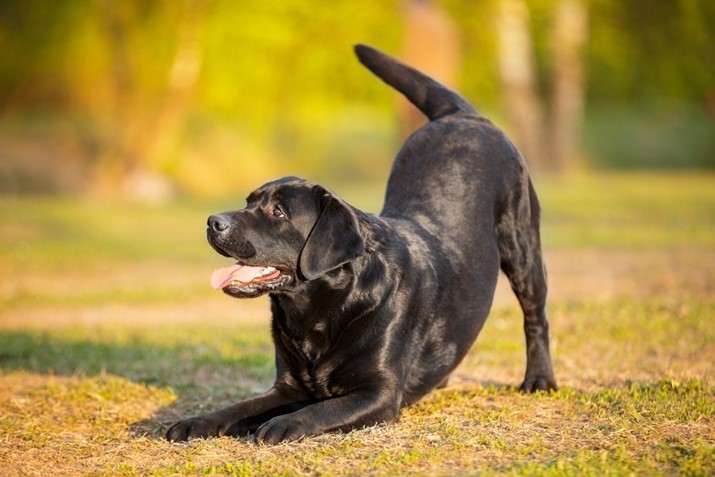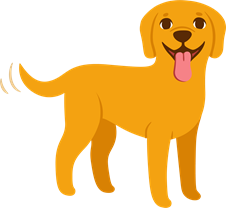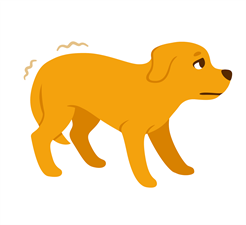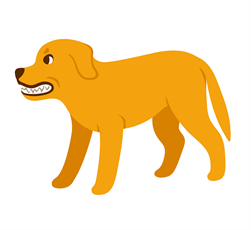Recognizing your dog's body language
Dogs use their bodies from head to tail in their communication to people and other animals. In this way, they can show whether they are happy or scared, for example. Because people naturally communicate very differently from animals, a dog's body language can sometimes be unclear. Therefore, it is important to be able to read a dog properly based on the signals he gives. In this blog you will find out what your dog is actually telling you if you look closely at his body language.

A dog's attitude
A dog's attitude is extremely important and constantly changing. The posture depends on the situation the dog is in, how he feels, how you feel as the owner and what the environmental factors are. When we look at a dog's body language, we pay attention to its posture, the position of its ears, the direction of its hair and the position of its tail. We also pay attention to the mouth, eyes and pupils.
What can you tell from a dog's body?
Body posture
When the dog adopts a high body posture, he feels himself confident and tough. He holds his head up, stands as straight as possible on his legs, and the ears and tail are up. When a dog assumes a high body position but keeps its tail low, the dog is not at that moment as tough as he wants to make himself out to be. It can also be the case that the hairs on your four-legged friend's neck and back stand up, which is often a sign of fear or just anger.
The position of the ears
A dog's ears are in a "normal position" when the ears are relaxed. They should not be pointed backwards. You can recognize a relaxed ear position by an auricle turned slightly to the side. When a dog is alert, he will keep his ears pointed forward. If a dog carries his ears backward, this can have several reasons. He may be anxious, he may want to flee or he may want to greet you in a friendly way. Therefore, it is important to focus not only on the ears, but to pay attention to the dog's entire body posture.
The hair
You can also notice different signals from the coat. The hairs on the back lie neatly on the skin when the dog is relaxed. With a fearful or aggressive attitude, the hair will stand straight up on the neck and back of the dog. This is an important warning signal.
The tail
Your four-legged friend knows three tail postures, neutral, high and low. When a dog is not communicating, it has its tail in a neutral position. When a dog has its tail straight up, it feels confident or excited. A dog with a low tail position often does not feel himself as confident. Wagging is a good sign in most cases. If the dog moves its tail in a slower, wider path, your dog probably feels satisfied.
The mouth
In a relaxed dog, the mouth often hangs slightly open.
The eyes and pupils
In relaxed dogs, the eyes and pupils are not open and the whites of the eyes cannot be seen. They have a normal shape and size.
Warning signals
Dogs can show various warning signals. It is important to recognize these immediately to prevent a situation from getting out of hand. Many people think that a dog shows aggressive behavior only when he is confident. This is not the case. The majority of dogs that bite do so as a result of fear aggression. When a dog feels threatened and becomes fearful, it will bite off to defend itself. Good to know is that dogs rarely do this without giving signals in advance. Therefore, pay close attention if a dog exhibits one or more of the following signals:
- Growling or growling barks
- Biting
- Body stiffening and/or staring at you
- Teeth bared
Different emotions of dogs listed
A relaxed body posture
With a relaxed body posture, clear signals can be seen:
- The position of the ears is relaxed and they droop.
- The eyes and pupils have a normal shape and size. The eyes are not open and the whites of the eyes cannot be seen.
- When the tail is straight up, a dog feels confident and excited. When your dog's tail moves in a slow, wider path, your dog probably feels content.
- The hairs on the dog's back are also smooth and lying on the skin.

An anxious body posture
A frightened or nervous body posture also shows clear signals:
- A dog will most likely stiffen when it assesses the situation and decides it must flee or fight.
- The dog ducks or makes himself small.
- A dog's eyes appear larger than normal when it feels threatened. Dogs that are uncomfortable may appear to squint.
- When a dog is scared or nervous, it will pull its ears back slightly. If he is very scared, the ears will lie completely in his lek.
- Yawning is a stress signal in dogs. Besides yawning, licking the mouth, moving the tongue back and forth, drooling, twitching, panting and high-pitched barking are also stress signals.

An irritated or aggressive body position
Take care if your dog or another dog shows signs of fear or aggression. In such cases, try to remove the dog from the situation as quickly as possible. Different signals are also visible with this body posture:
- Dogs with an aggressive posture have erect or pointed ears.
- Dogs with aggression stand up straight and make themselves big.
The dog will look straight at you and he places his body slightly forward. He then often braces his paws as well. - The dog's tail stands stiffly up and makes short, ticking movements or, on the contrary, it twitches a lot.
- An aggressive posture often involves bared teeth. The dog may also growl or growl bark.
- In addition to the warning signs that dogs show when aggressive, dogs may actually bite or bite. If the dogs bite then there is also a definite chance that they will hold on and not just let go.

An alert body posture
Once a dog is alert, he has an attentive gaze focused on whatever has caught his attention. Its ears are forward and its body is somewhat tense. He is ready to react.

Continue reading under the block
Curious? look at our offer
The sounds a dog makes
In addition to using its body as a means of communication, a dog can of course make sounds to make something clear. To understand your dog even better, you will have to learn to understand the sounds that dogs make. There are, in fact, several different types of barking. Here the intonation, the volume of the sound, the pitch and the duration of barking play a major role. If your dog barks bright tones, these are often meant to be friendly and playful. The deep tones your dog will make are often associated with a threatening situation. Below we describe different ways a dog can bark:
The barking of dogs
- The bark for attention: when the dog keeps looking at you questioningly and barks a number of times in quick succession in a normal tone, possibly with pauses, you can assume that the dog is asking for your attention.
- The game bark: a dog may let out a short series of sharp barks during a game with its master or with another dog. This often includes a busy wagging tail and feints to challenge the master or the other dog.
- The excited bark: an excited dog may bark higher than normal out of enthusiasm, usually in series.
- Barking out of fear: when the dog is anxious, it may also express this by barking. This bark is similar to the excited bark, but often lasts a little longer. You can also tell the difference between an excited bark and a bark out of fear by the body posture. Dogs that are anxious show stress signals and in most cases will try to flee.
- The bark out of defense: a dog that lets out a heavy and sharp bark feels threatened. This threat can have different causes, such as a situation caused by a human or by other animals. As mentioned earlier, the dog will probably have already given several signals before it lets out a bark in defense. In addition to barking, a dog may also jump forward and bite.
- Barking out of frustration or stress: when the dog experiences prolonged stress or frustration, the dog may let out a sustained, monotonous bark as a result. This bark is often lower than the normal bark and may be complemented by a howl. Restless behavior such as scratching, digging and pacing may also indicate that the dog is stressed or frustrated.
Dog growling
In dog language, growling in most cases means that your animal is not enjoying himself. He is tense, anxious or in pain. Therefore, pay close attention to the body language your dog shows in addition to growling.
- Deep growling: your dog is warning or threatening and is probably preparing to attack. Possibly he shows his teeth and wrinkles appear just above his nose. But beware; behind the growling may also be pain.
- Growling and recoiling: if a dog growls and adopts an evasive or recoiling posture, he feels seriously threatened.
- Gentle growling: this may also sound like grunting in some dogs. In most cases, the dog is expressing satisfaction and this should not be confused with a threatening or grumbling growl. Soft growling involves a relaxed attitude on the part of your dog.
Dogs that whine and squeak
Whining and squealing are clear signals in dog language that your animal is not feeling well. A dog that whines and squeals is usually feeling lonely or sad. However, it can also be a sign of pain. In that case, most dogs squeak softly and with their mouths closed. Furthermore, whining and squealing can also be the learned behavior of a dog who has (too) often (unconsciously) had his way when he showed this behavior.
Howling like a wolf
The typical howling of dogs, as their primordial ancestor the wolf does, has a different meaning than soft whining and squealing. Often dogs try to get attention from their owners or to make contact with conspecifics in this way. Howling is a distinctive sound that is quite difficult to ignore; it is a literal cry for attention. Howling can have several causes. For example, the dog may be reacting to external stimuli (the sound of a siren) or he may thus want attention from his master or from another dog. In addition, the dog may also cry out of discomfort, such as when he is nervous, has separation anxiety or is injured.
What does a dog's panting say?
A dog panting when it is hot or after strenuous physical exertion is basically showing normal behavior. This is his way of cooling off. However, if your dog keeps panting after exertion and possibly drooling along with it, it may indicate overheating. Panting without physical exertion may also indicate anxiety, pain symptoms such as abdominal cramps or tightness in the chest.
How do you communicate properly with a dog?
Communication is and always has been a tricky concept. Unfortunately, there is no instruction book for sale that describes how best to react in certain situations. Nevertheless, there are some tips that can help you communicate with your dog in the best possible way:
- Give commands in a calm, positive tone while paying attention to your own body language
- The pitch and volume of your voice are very important
- Shouting is not necessary; dogs have excellent hearing
- Use clear, short signals
A good basic education is very important for every dog. A puppy course can help you with this. In our blog "The importance of puppy classes" we tell you why a puppy class is very valuable for both your puppy and yourself as a dog owner. Do you have an adult dog but still sometimes find it difficult to understand his body language? Then you can enlist the help of a behaviorist.












